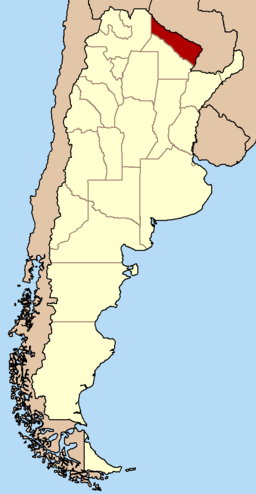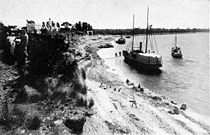Formosa Province
| Formosa | |||
| Province | |||
|
|||
| Capital | Formosa | ||
|---|---|---|---|
| Area | 72,066 km² (27,825 sq mi) | ||
| Population | 486,559 (2001) | ||
| Density | 6.75 /km² (17 /sq mi) | ||
| Governor | Gildo Insfrán | ||
| - Senators | Adriana Bortolozzi, Luis Petcoff Naidenoff, José Mayans | ||
| ISO 3166-2 code | AR-P | ||
| Demonym | Formoseño | ||
 |
|||
| Website: http://www.formosa.gov.ar | |||
Formosa Province is in northeastern Argentina, part of the Gran Chaco Region. Its northeast end touches Asunción, Paraguay, and borders the provinces of Chaco and Salta to its south and west, respectively. The capital is Formosa.
Contents |
History

Native inhabitants of these lands include the Pilagás, Wichis and Tobas, whose languages are still spoken in the province.
Sebastián Gaboto and Diego García first explored the area at the beginning of the 16th century trying to find a route from Viceroyalty of Peru to Asunción. Because the rivers Pilcomayo and Bermejo are so shallow, the attempts to set a route towards Asunción was abandoned.
Even though the first settlement was Concepción del Bermejo established in 1585, it was not until the 19th century, after the War of the Triple Alliance that the territory's population started growing.
By 1914 Formosa had less than 20,000 inhabitants; but in 1955, when it acquired province status by a decree of Juan Domingo Perón, it had already more than 150,000.
Geography and climate

Located within the geographic coordinates 26° - 22°30' South, and 57°30' - 62°25' West, the plains run between rivers Bermejo and Pilcomayo with a slight inclination towards the Southeast. Due to this flatness, riverbeds are not stable, and small lagoons that are slowly reabsorbed arise. The average annual temperature is 21°C, and during the summer it can go up to 45°C
The subtropical weather is characterized with uniform annual rains in the east (1000 mm annual), while in the rest of the country winter is a drier season (80 mm). The humidity variation results in the jungle vegetation on one side, and the Chaqueño forest in the other. The limit with the Salta Province is known as the Impenetrable ("Impenetrable").
Formosa's protected areas are the Río Pilcomayo National Park and the Formosa National Reserve.
Economy
Remote and saddled by its inhospitable geography and climate, Formosa's economy has long been one of Argentina's poorest. Its economy in 2006 was estimated at US$2.1 billion, or, US$4,280 per capita. Its economy is the third smallest and second least developed in Argentina yet has shared in Argentina's recovery since 2002 very well.[1]
Poorly industralized, Formosa's economy is based on cattle and agricultural activities like cotton and fuit cultivation, these mostly centered in the Patino, Pilagás and Pilcomayo departments.
Cattle in Formosa exceed 1.5 million head and ranching has long been the agricultural mainstay of the province. Like elsewhere in Argentina, agriculture has long since been overtaken by other activities and amounts to about 10% of Formosa's output (somewhat more than average).
Cotton cultivation passed from over 100,000 tons at the end of the 1970s to 10,000 at the end of the 1990s because of the drop of the international price, and the fixed exchange rate. After the 2001 crisis production slightly revived to 50,000 tons a year in 2004. More than 70% of area sown with cotton belongs to small family-run farms of less than 10 hectares.

Cotton represents half of the agricultural wealth of the province followed by soybean (25,000 tons a year) and maize (55,000 tons), who have experienced a less dramatic invigoration after the 2001 crisis.
The production of bananas, mainly for domestic consumption, has a still growing annual average of 70,000 tons. Citrus and juice production for exportation, specially grapefruit, is gaining more space, with 1,200 planted hectares and an annual production of around 15,000 tons.
Others; honey (273 tons) and derivatives, timber-wood (140,000 tons) and textile industry (cotton, leather).
Tourist infrastructure is little developed. Sites of interest include the city of Formosa, the Río Pilcomayo National Park, Bañado La Estrella, Laguna Yema, Herradura town, and Misión Laishí.
Political division
The province is divided into nine departments:

Department (Capital)
- Bermejo (Laguna Yema)
- Formosa (Formosa) - The most populous department (40% of the province's population).
- Laishí (San Francisco de Laishí)
- Matacos (Ingeniero Juárez)
- Patiño (Comandante Fontana)
- Pilagás (Espinillo)
- Pilcomayo (Clorinda)
- Pirané (Pirané)
- Ramón Lista (General Enrique Mosconi)
Trivia
- The name of the city (and the province) comes from the archaic Spanish word fermosa (currently hermosa) meaning "beautiful". The name Vuelta Fermosa or Vuelta la Formosa was used by Spanish sailors in the 16th century to describe the area where the Paraguay River makes a turn, right in front of the actual city. These sailors were searching for the legendary Sierra del Plata.[2]
- Formosa is mentioned in the novel Travels with My Aunt, by Graham Greene.
- The antipode of Formosa is Taiwan, which, coincidentally, was also known as Formosa.
References
External links
- Provincial government (Spanish)
- One-page info: enconomic info, with a map (can be enlarged)
- Tourist Office (Spanish)
- Encyclopedia Libre article (Spanish only)
- Provincial portal (Spanish only)
|
||||||||||

